Two north-east Victorian growers who farm in neighbouring districts at Rutherglen and Norong share a keen interest in intercropping, being the practice of growing different crops together in space or time.
One example of intercropping is companion cropping in which two or more crops are grown together.
In these case studies, Victorian growers Ashley Fraser from Rutherglen and Tom Briggs from Norong, relate their on-farm experiences growing two types of companion crops. These include twin cropping (partnering two different crop species) and multi-species cropping.
Ashley has experimented with twin cropping, pairing field peas and canola, while Tom grows a multi-species crop, typically combining millet, sunflowers and buckwheat.
Both growers were keen spectators of local intercropping trials at the Rutherglen Research Institute as part of the Victorian Grains Innovation Partnership (VGIP) with co-investment from GRDC and Agriculture Victoria.
The Rutherglen trial site was one of three main sites, also established at Horsham and Hamilton, plus six satellite sites at Inverleigh, Willaura, Curyo, Netherby, Burramine South and Caniambo.
Companion cropping was the main focus of this state-wide Victorian trial program, led by Agriculture Victoria senior research scientist Dr Garry O’Leary.
Snapshot
Owners: Ashley and Pam Fraser, Andrew and Sue Russell
Businesses: grain, seed and sheep production trading as Lilliput-Ag; seed cleaning and marketing trading as Baker Seed Company
Location: Rutherglen, Victoria
Area: 2500 hectares
Average annual rainfall: 600 millimetres
Soil types: sandy loam over buckshot clay
Ph range: 5.2 to 5.6
Crops: wheat, canola, oats, barley, triticale, faba beans, field peas, lupins
Companion crop: field peas-canola
Livestock: 4000 self-replacing Merino crossbred ewes
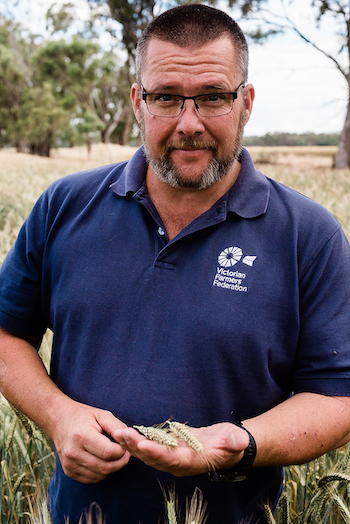 Victorian grower Ashley Fraser is rethinking the potential for twin cropping on his family’s farm at Rutherglen. Photo: Georgie James
Victorian grower Ashley Fraser is rethinking the potential for twin cropping on his family’s farm at Rutherglen. Photo: Georgie James
Intercropping has roots in the past, present and future of a 2500ha mixed farm at Rutherglen run by farming couples Ashley and Pam Fraser, and Andrew and Sue Russell.
The family farm comprises two main ventures. It includes a seed cleaning and marketing business, Baker Seed Company, managed by Ashley, plus a mixed farm business, Lilliput-Ag, managed by Andrew.
Lilliput-Ag grows wheat, canola, oats, barley, triticale, faba beans, field peas and lupins to produce grain, as well as seed for Baker Seed Company.
The partnership’s foray into twin cropping, combining field peas and canola, began as an experimental strategy to lift the quality of field peas grown for seed production about 10 years ago.
Ashley says the impetus for growing the companion crop was low-quality field peas, leading to low germination rates, estimated at 40 to 45 per cent, which rendered the seed crop unsaleable.
They opted to grow canola as a companion to field peas because the seed quality issues were thought to be caused by mechanical damage during harvest and storage operations.
The idea being that when the two crops were harvested and stored together, the tiny, abundant canola seed would surround the larger field pea seed, acting as a ‘lubricant’ protecting the legume from mechanical damage.
The canola and field peas were commingled during windrowing, harvesting and storage, with the commodities only separated in the final stages of seed cleaning. There was no extra cost for cleaning the two seeds types together, but there was an additional cost of $20 per tonne for separating the field pea and canola commodities.
Ashley says the strategy was effective, with the field peas showing improved quality, particularly a reduction in stress-cracked seed. In turn, the crop also showed slightly improved germination rates, which increased by about 10 per cent.
But it still missed the mark for marketable seed, targeting a minimum germination rate of 85 per cent. This suggested the substandard germination stemmed from the cultivar’s genetic make-up, rather than mechanical damage, he says.
The finding that the field pea cultivar was unsuitable for seed production was communicated to pulse pre-breeders and breeders for varietal improvement, plus the cultivar was removed from the cropping program at Lilliput-Ag.
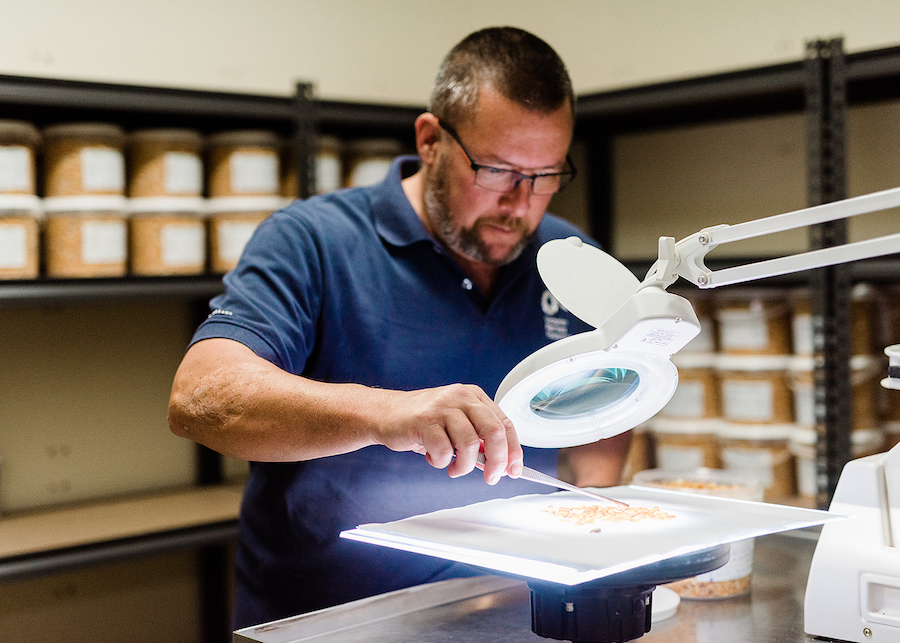
Ashley Fraser has experimented with twin cropping, partnering field peas and canola, as part of a strategy to lift the quality of field peas grown for seed production. Photo: Georgie James
Not only did the companion crop help solve the low germination mystery, it also provided a slew of clues that intercropping might provide other farm business gains.
Ashley says the twin crop showed potential to boost the profitability of grain and seed production by reducing input costs, such as herbicides, fungicides and nitrogen fertiliser.
He found, for example, that there was a stark contrast between disease pressure from Sclerotinia stem rot in the twin crop compared to canola grown as a monoculture crop.
Monoculture canola grown on one-third of the farm’s cropping area, as well as 40 control plots of monoculture canola in the twin crop, showed severe Sclerotinia infestation. He estimates about 95 per cent of the monoculture canola was infected with Sclerotinia.
“But there was not a skerrick of Sclerotinia in the twin crop,” Ashley says.
Plus, he found the climbing habit of the field peas wove the canola into a dense, tangled mat of vegetation that prevented sunlight from penetrating the canopy, effectively ‘choking’ in-crop weed competition.
As such, Ashley hopes twin cropping might reduce fungicide and herbicide control costs, with decreased reliance on synthetic chemistries also promoting soil biota and beneficial insects.
Cost savings on nitrogen fertiliser is another theoretical benefit of twin cropping that Ashley finds attractive. He plans to grow field peas or faba beans with canola to capitalise on the effect in which a legume trickle-feeds fixed soil nitrogen to its crop companion, or the following crop.
Rutherglen trial findings

Researchers put intercropping to the test at the Rutherglen trial site. Photo: Agriculture Victoria
The benefit of twin cropping combining legume and oilseed species is consistent with the findings of trials at the Rutherglen Research Institute as part of VGIP research from 2019–21.
Research leader Dr Garry O’Leary says the trials showed twin crops, coupling legume and oilseed species performed better than those combining cereal and oilseed species.
He says that, overall, the research identified two main options as profitable winter companion crops: field peas-canola and faba beans-canola.
These are the twin crops that Ashley plans to grow on his family’s property in the next five years, based on the trial findings and his firsthand experience.
The local trial findings were compelling, he says, with 16 of 23 twin crops producing more profit than monoculture crops at the Rutherglen site. But Dr O’Leary adds that the profitability of twin cropping also depends on seed separation costs. “Some twin crops are more costly to separate depending on the relative grain sizes of the two crops,” he says.
Nevertheless, the research suggested that twin crops could not only increase profitability, but also yield in some cropping areas of southern Australia. Specifically, these tended to be high-rainfall areas, such as Victoria’s north-east region.
Ashley says his experience growing field peas-canola saw a yield sacrifice in both crop species compared with their monoculture counterparts. He estimates there was a 40 per cent yield penalty in the canola, and a 20 per cent penalty in the field peas, when the crops were grown as companions.
But he thinks there might be scope to overcome these yield losses by better aligning the crop maturation of cultivars for each species. The partnership previously grew a late-maturing field pea variety with a mid-maturing canola variety.
However, Ashley emphasises that twin cropping in not without its challenges. For example, the operational difficulties of sowing two crop species together, and windrowing and harvesting the dense tangle of field peas and canola.
“It took twice as long to harvest the field peas-canola compared to our monoculture crops,” he says. “Aligning the maturation rate of different varieties for each crop so that grain ripens at the same time for harvest is also a challenge.”
Summer crops soak up waterlogging
Snapshot
Owners: Tom, Colin, Jill, Ray, Helen Briggs
Area: 900 hectares owned and leased
Location: Norong (710ha), Boorhaman (190ha)
Soil pH: 4.5 to 5.5
Soil types: loam, heavy grey and blue clays
Average annual rainfall: 500 to 550 millimetres
Crops: wheat, barley, triticale
Companion crop: millet, sunflowers, buckwheat
Sheep enterprise: 1200 self-replacing Merino and composite ewes
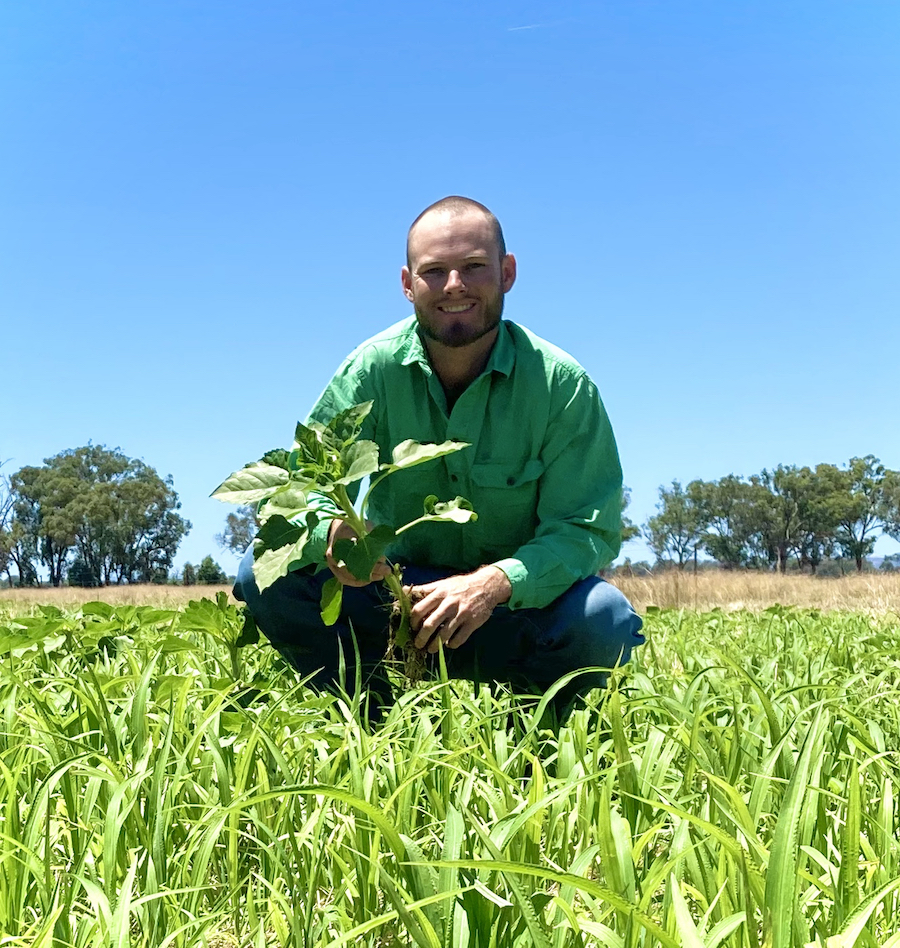
Tom Briggs in a multi-species ground cover crop grown on his family's farm at Norong in north-east Victoria this summer. Photo: Colin Briggs
Victorian growers Tom and Colin Briggs have implemented a multi-species ground cover cropping program to brace the foundation of soil health that underpins the family’s 900-hectare mixed farm in the state’s north-east.
Tom says the core aim of the intercropping program, including a mix of summer crop species, is to build soil structure and functionality since waterlogging is the main constraint to crop production on their properties at Norong and Boorhaman.
“Waterlogging is our Achilles heel,” Tom says of the farms where annual rainfall averages 500 to 550 millimetres.
An initial 40ha companion cropping trial area was established on the family’s main 710ha property at Norong. But Tom also independently farms another 190ha property at Boorhaman, about 20 kilometres south of Norong.
Highlighting the waterlogging penalty in these high-rainfall districts, Tom says water inundating paddocks during winter can rob cash crops of more than half their yield potential. For example, he estimates waterlogging caused crop losses totalling $150,000 at Norong in the wet winter of 2016.
The waterlogged conditions in 2016 were a catalyst for major practice change. It was the year that Tom returned to the family farm, determined to tackle its soil constraints, following a five-year hiatus working on a farm in Queensland.
There, he resolved to implement new soil health-sensitive measures once back on the family farm. His objective was to, in some ways, re-create the high-performance traits of the fertile, black self-mulching clay soils that characterise many farming systems in the northern grains region.
Chasing this objective, the Briggs family exchanged the traditional district practice of stubble burning for stubble retention and began exploring other options to boost soil performance as part of the Victorian No-Till Farmers Association.
Tom started exploring the potential for ground cover cropping to improve soil structure and health, based on his observation in the wet 2016 season that perennial lucerne tolerated waterlogging better than their annual winter crops. The family’s wheat averaged 1.5 tonnes per hectare and the lucerne averaged 5t/ha in those saturated conditions.
This observation prompted Tom to measure the infiltration rate of water into the soil using the ring infiltrometer method. He pushes a metal infiltration ring into the soil to a depth of 15mm. An inch of water, equivalent to 25mm, is then poured into the ring, and the time it takes the water to soak into the soil surface is recorded.
Infiltration findings
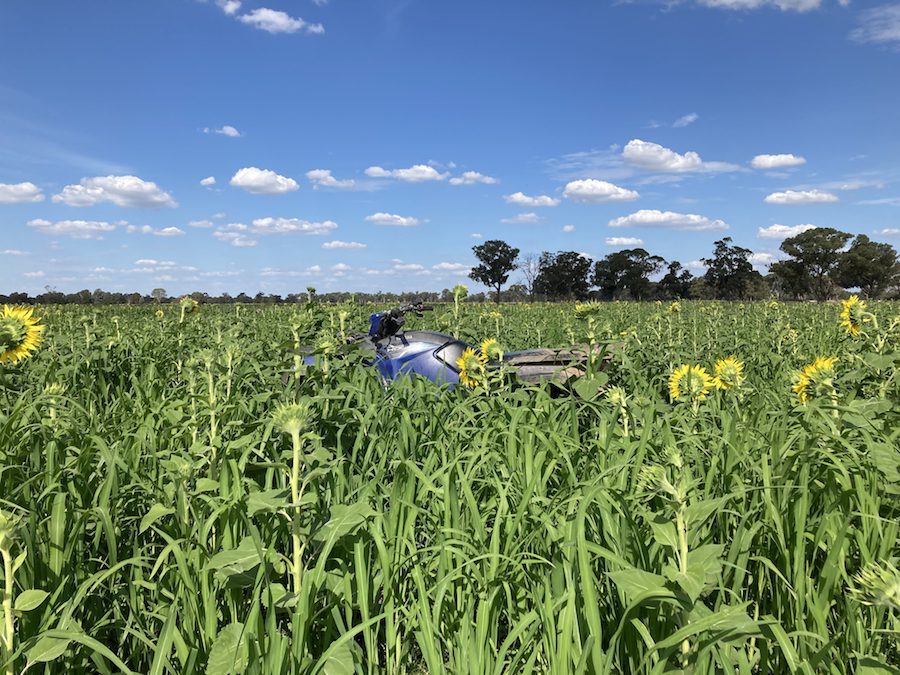
The Briggs family grow a mix of summer crop species, mainly millet, sunflowers and buckwheat, on 200 to 300 hectares of their Norong property. Photo: Tom Briggs
Using this method, Tom found it took 20 minutes for the water to infiltrate the soil surface where annual winter crops were continuously grown. But it took half that time to infiltrate on soils planted with perennial lucerne. He also found it took just four minutes for the water to infiltrate into the soil on an area of lawn beside the house where perennial grass species had provided permanent ground cover.
“Beneath Mum’s lawn where grass is constantly growing, there were black, beautiful soils that resembled the self-mulching soils in Queensland,” Tom says.
He acknowledges that this lawn area has not been depleted by long-term nutrient removal from continuous crop production.
Nevertheless, it still highlighted the scope for soil improvement that could be achieved and provided the impetus to introduce the 40ha companion cropping trial in the 2016-17 summer to maximise ground cover and minimise soil disturbance. The trial area was expanded two years later, with the multi-species crop grown on 200 to 300ha of their Norong property since the 2018-19 summer.
Although the program’s main aim was to reduce waterlogging losses, its secondary objectives were diverse. It also aimed to minimise soil moisture losses, boost soil organic carbon, stimulate soil biota, fix nitrogen in the soil and provide feed for the family’s sheep.
Of these objectives, Tom has seen the program provide three main benefits over the past five years – improved soil moisture infiltration, increased soil organic carbon content and abundant sheep feed.
He has been able to measure the soil gains against a 0.5ha control plot set up inside the 40ha trial paddock where cover crops are grown.
The control or test area is representative of the soils on the farm’s winter cropping area, sown with wheat, barley and triticale. It is treated as a fallow during summer, and receives the same management regime as winter crops, including stubble retention, crop nutrition and applied chemistry.
Ongoing investigation using the ring infiltrometer has shown major improvement in soil moisture infiltration, Tom says.
Within 18 months of establishing the program, for instance, the method indicated it took half the time for water to soak into soil on the cover cropping area, when measured against the test area. This finding was consistent at different locations across the cover cropping paddock, he says.
“It took just 10 minutes for water to infiltrate the soil where we had grown cover crops, compared with 20 minutes in the test area,” he says. “Seeing the water infiltration rate halved was an important development that demonstrated water was not sitting on the soil surface for as long, contributing to that waterlogging effect.”
And digging a little deeper with a shovel beneath the infiltration ring, Tom found that the water had penetrated deep into the soil profile via root channels created by the different summer crop species.
He noted that in the early years of the program, the root structure of summer crop species was severely stunted and tended to grow horizontally in shallow soil layers.
But over time, the different summer species were able to develop more robust root systems. This larger and longer root architecture has generated new pathways for soil moisture infiltration, while enabling plants to more effectively forage for moisture and nutrients at depth in the soil.
Increased organic soil carbon is another major gain stemming from multi-species summer cropping, Tom says. In 2020, soil sampling to a depth of 10cm showed a lift in soil organic carbon in the cover cropping area compared to the test area.
The cover cropping program has also produced valuable feed for the family’s 1200-head sheep enterprise, with Merino and composite ewes typically grazed on the diverse blend of crops for two months during summer.
“The big flush of green feed the cover crops provide is an added bonus. Aside from brief stints during two dry periods, our sheep have not seen dry feed since 2016,” he says.
Learning curve
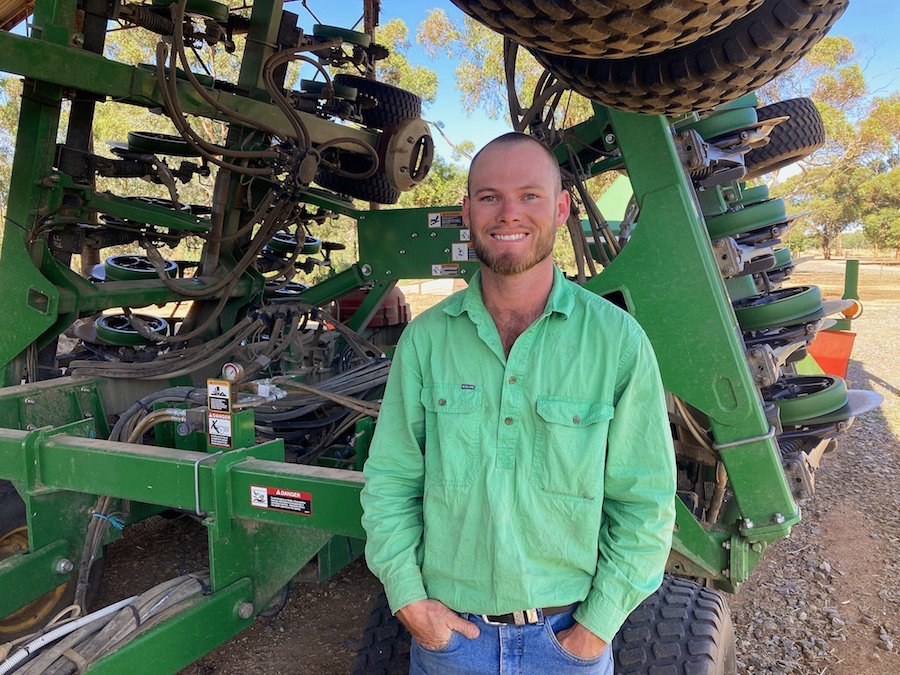
Tom Briggs has started planting summer crop species at greater depth in the soil using a disc seeding machine. Photo: Colin Briggs
Tom sees the program as a continual learning curve. In the first year of the program, for example, they grew a mix of 10 different summer species: millet, sunflowers, buckwheat, radish, sunn hemp, forage sorghum, safflower, lentils, field peas and maize.
But using a selection process, guided by crop performance, seed cost and feed value, they have whittled this crop diversity down to three main species: millet, sunflowers and buckwheat.
“We set a budget for the cover cropping program due to the high cost of seed for some summer crop species, which we also found were underperforming on our farm,” he says. The cost of sunn hemp seed, for instance, is nearly $70/ha.
However, the species mix is also determined by crop seed availability. In the 2021-22 summer, they only grew millet and sunflowers due to the limited availability of buckwheat seed.
In the 2019-20 summer, the father-and-son team also started using their disc seeding machine to plant summer crops at greater depth in the soil, where more moisture is available.
They found that planting summer crop species at a soil depth of two to three centimetres resulted in low crop emergence, estimated at 20 per cent. “Moisture moved down through the soil before plants could establish root systems,” Tom says. But sowing summer crops into moisture at a soil depth of 4cm has increased emergence to about 80 per cent, he says.
More information: Ashley Fraser, 0418 176 764, ashley.fraser@bakerseedco.com.au; Tom Briggs, 0448 409 124, tkbriggs91@gmail.com

























































